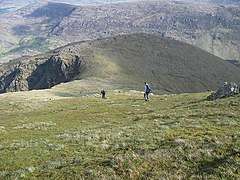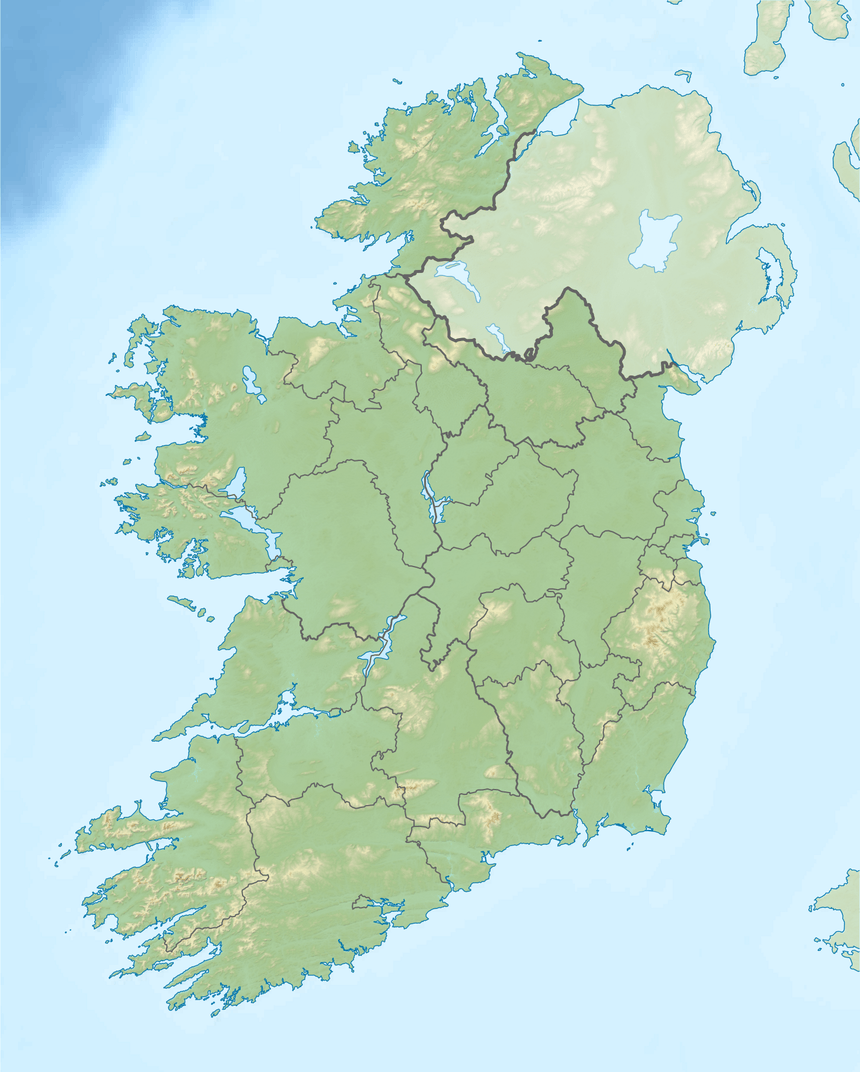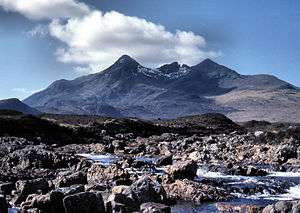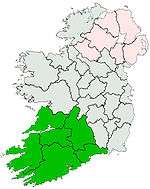Brassel Mountain
Brassel Mountain (Irish: Cnoc Breasail, meaning "hill of the raddle")[lower-alpha 1][2] at 575 metres (1,886 ft), is the 261-st highest peak in Ireland, on the Arderin scale.[3] It is part of the MacGillycuddy's Reeks range in County Kerry. Brassel Mountain is the south-east spur of the larger neighbouring peaks, Cnoc an Chuillinn 958 metres (3,143 ft), and Cnoc an Chuillinn East Top 926 metres (3,038 ft). Because of its positioning away from the main ridge of the Reeks, and away from the glens used to access the Reeks (e.g. the Hag's Glen), Brassel is less frequently climbed, but can be used as an exit, or entry point to the main ridge.[4][5]
| Brassel Mountain | |
|---|---|
| Cnoc Breasail | |
 Walking towards Brassel Mountain from the summit of Cnoc an Chuillinn | |
| Highest point | |
| Elevation | 575 m (1,886 ft) [1] |
| Prominence | 50 m (160 ft) [1] |
| Listing | Arderin |
| Coordinates | 51°58′52″N 9°42′13″W |
| Geography | |
 Brassel Mountain Ireland | |
| Location | County Kerry, Republic of Ireland |
| Parent range | MacGillycuddy's Reeks |
| OSI/OSNI grid | V830822 |
| Topo map | OSI Discovery 78 |
| Geology | |
| Mountain type | Green sandstone & purple siltstone Bedrock |
Notes
- Paul Tempan notes in his Irish Hill and Mountain Names (2010), that the Irish Ordnance Survey Name Book suggests that Breasal is a man's name, but that a connection with raddle, the red-dye traditionally used to mark sheep, seems more likely.[2]
gollark: They do have to spin pretty fast. There are sealed helium ones now.
gollark: > The HDD's spindle system relies on air density inside the disk enclosure to support the heads at their proper flying height while the disk rotates. HDDs require a certain range of air densities to operate properly. The connection to the external environment and density occurs through a small hole in the enclosure (about 0.5 mm in breadth), usually with a filter on the inside (the breather filter).[124] If the air density is too low, then there is not enough lift for the flying head, so the head gets too close to the disk, and there is a risk of head crashes and data loss. Specially manufactured sealed and pressurized disks are needed for reliable high-altitude operation, above about 3,000 m (9,800 ft).[125] Modern disks include temperature sensors and adjust their operation to the operating environment. Breather holes can be seen on all disk drives – they usually have a sticker next to them, warning the user not to cover the holes. The air inside the operating drive is constantly moving too, being swept in motion by friction with the spinning platters. This air passes through an internal recirculation (or "recirc") filter to remove any leftover contaminants from manufacture, any particles or chemicals that may have somehow entered the enclosure, and any particles or outgassing generated internally in normal operation. Very high humidity present for extended periods of time can corrode the heads and platters. https://en.wikipedia.org/wiki/Hard_disk_drive#Integrity
gollark: Interweb says it's to keep pressure equalized between the inside and out.
gollark: Ah yes, destroy it as an example to the others.
gollark: I find that threatening my electronics with a hammer or something works.
References
- Brassel Mountain at mountainviews.ie. Accessed on 7 Feb 2013.
- Paul Tempan (February 2012). "Irish Hill and Mountain Names" (PDF). MountainViews.ie.
- "Arderins: Irish mountains of 500+m with a prominence of 30m". MountainViews Online Database. October 2018.
- Ryan, Jim (2006). Carrauntoohil and MacGillycuddy's Reeks: A Walking Guide to Ireland's Highest Mountains. Collins Press. ISBN 978-1905172337.
- Dillion, Paddy (1993). The Mountains of Ireland: A Guide to Walking the Summits. Cicerone. ISBN 978-1852841102.
See also
| Wikimedia Commons has media related to MacGillycuddy's Reeks. |
External links
- MountainViews: The Irish Mountain Website
- MountainViews: Irish Online Mountain Database
- The Database of British and Irish Hills , the largest database of British Isles mountains ("DoBIH")
- Hill Bagging UK & Ireland, the searchable interface for the DoBIH
- Ordnance Survey Ireland ("OSI") Online Map Viewer
- Logainm: Placenames Database of Ireland
This article is issued from Wikipedia. The text is licensed under Creative Commons - Attribution - Sharealike. Additional terms may apply for the media files.

